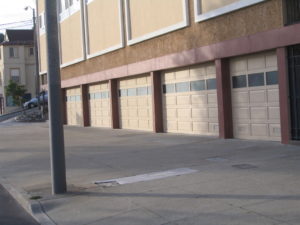San Francisco removes minimum parking requirements citywide
 On December 21, the Mayor signed Supervisor Jane Kim’s ordinance eliminating minimum parking requirements citywide. The ordinance goes into effect on January 20.
On December 21, the Mayor signed Supervisor Jane Kim’s ordinance eliminating minimum parking requirements citywide. The ordinance goes into effect on January 20.
In October, the City’s Planning Commission unanimously recommended removing citywide parking requirements as part of their review of legislation to limit new driveways along the City’s most important transit, walking, and cycling streets. Given the choice of adding more caveats to the Planning Code’s parking exceptions or eliminating minimums, the commission opted to recommend doing away completely with minimum requirements. Supervisor Kim agreed to act on their strong recommendation. The legislation was heard twice at the Board of Supervisors’ Land Use and Transportation Committee, with City and Bay Area environmental, sustainble transportation, and housing advocates – Livable City, Walk San Francisco, SF Bicycle Coalition, Transform, SPUR, Housing Action Coalition, and YIMBY Action – testifying in favor of the legislation, along with the City’s Planning Department, SFMTA, and Transportation Authority. At the full board, supervisors Kim, Brown, Mandelman, Peskin, Ronen, and Tang voted in favor.
Recent research continues to confirm what wise urbanists and planners have known for decades. Minimum parking requirements increase auto traffic in cities, and with it pollution and congestion. Minimum parking requirements make cities less healthy and less sustainable. Private cars are now the largest source of greenhouse gases in California, and an increasing one. Minimum parking requirements make housing more expensive to build, to rent, and to buy. Minimum parking requirements replace storefronts, walk-up housing, front gardens, and street trees with garage doors and driveways, making our neighborhoods and sidewalks less safe, less accessible, less green, and less appealing for people walking, cycling, and riding transit, particularly seniors, children, and people with disabilities.
Minimum parking requirements are an anachronism, a relic of the post-World War 2 project to retrofit walkable, compact, and transit-rich cities like San Francisco for domination by the automobile. The automobile-obsessed planning of that era imposed parking requirements, bulldozed freeways through city centers and urban neighborhoods, narrowed sidewalks and widened neighborhood streets into traffic sewers, tore up streetcar tracks, and displaced homes and businesses to build parking lots and garages.
That 1950s project was disastrous for cities, and citizens rose up to reclaim their streets and neighborhoods. San Francisco’s freeway revolt from 1959 to 1966 stopped urban freeway construction, and the City removed the earthquake-damaged Embarcadero and Central freeways after the 1989 quake. In the 1960s San Franciscans voted to build BART and the Muni Metro under Market Street, and later voted to rebuild streetcar lines, extend Caltrain, and expand and improve bus and ferry service. In the 1970s, the city began successful experiments with neighorhood traffic-calming, and started to install bicycle lanes in the 1990s. For decades the City has embraced, and affirmed and reaffirmed at the ballot box, a transit-first policy and a multi-modal transportation strategy that invests in transit, walking, and cycling and seeks to keep auto traffic in check.
Minimum parking requirements are incompatible with the livable, walkable, green, and sustainable urban future that San Franciscans prefer. Since the 1970s, the City has chipped away at the strict minimum parking requirements imposed in the 1950s, first Downtown and then outwards along some of the City’s many bus and rail corridors. The incremental approach has been successful. Neighborhood plans removed parking requirements in some places, while Livable City has worked with Supervisors to remove minimum requirements in many more neighborhoods, and for specific uses and circumstances. In 2007 voters overwhelmingly rejected Proposition L, which would have re-imposed minimum parking requirements outside the Downtown. In the past few years, the City has exempted accessory dwelling units and projects with increased affordability from minimum requirements citywide.
When eliminating minimum parking requirements is discussed, some people hear “ban on cars”, and start arguing why they or other people need a car for this or that, or how transit, walking, and cycling aren’t convenient enough or safe enough. Removing minimum parking requirements isn’t a ban on parking and driving. It makes automobility a choice rather than a government mandate. About a third of San Francisco households are car-free, and the majority of new households are car-free. Households who choose to do without a car can avoid the cost of buying, maintaining, and storing a car. Keeping minimum parking requirements in place does nothing to improve sustainable transportation options, and, by increasing traffic congestion and eroding the safety and utility of sustainable modes, makes the entire transportation system work worse. Removing parking mandates complements expanding sustainable transportation options, and better managing curb parking and loading. Relaxing parking requirements can even make living with cars easier, by reducing traffic congestion and turning unused driveways back into curb parking spots.
Reducing parking requirements is a national movement, as Strong Towns’ interactive map illustrates. San Francisco wouldn’t be the first US city to eliminate minimum parking requirements citywide – Hartford, Connecticut eliminated them last year. Finally eliminating minimum parking requirements would make San Francisco a progressive leader in the movement to reclaim cities for people, and in addressing the City’s escalating crises of housing affordability and automobile congestion, and easing the linked global environmental crises caused by automobile dependence.
